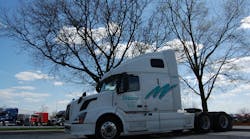Margo Oge, one of the chief architects of the overarching greenhouse gas (GHG) regulations that are currently mandating fuel economy improvements for U.S. light vehicles and heavy trucks alike, says that a major “good story” being overlooked about them is how they are designed so that “everybody wins” in the end – especially commercial fleets.
“It is really what I call ‘smart regulation,’ much smarter than what we did before,” Oge told Fleet Owner, referring to rules that phased in reductions in diesel particulate and oxides of nitrogen emissions between 2002 and 2010.“Under the emissions rules, we significantly reduced air pollution, resulting in cleaner air benefits for society. But did that cost more money to the fleets? Of course,” Oge (seen at right) explained. “The owners of the trucks did not get anything directly from those rules, though society gained.”
That’s why the GHG regulations are different – even the contentious Phase II section of the rules, which are expected to be released this week.
“Because these rules [GHG regulations] produce payback not just to society, but the truck owners save money by reducing fuel consumption,” she said. “Everybody gains. That’s the most important lesson; that is the good story here.”
Yet it is the potential up-front expense to comply with Phase II GHG rules that is worrying the industry for, according to the New York Times, they are expected to require a nearly 40% increase in heavy truck fuel economy by 2027 compared with 2010 levels – in essence boosting average tractor-trailer fuel economy from the current average of 5 to 6 miles per gallon (MPG) to near 9 MPG.
Oge, who retired in 2012 after a 32-year career with the Environmental Protection Agency (EPA), spent 18 years as director of the agency’s office of transportation and air quality and helped craft not only the current GHG rules but the aforementioned diesel exhaust reduction regulations as well.
Oge also authored her new book – entitled Driving the Future: Combating climate change with cleaner, smarter cars – in part to help illuminate the behind-the-scenes decision-making behind those two regulatory efforts, she explained.
“For the most part, when we [government agencies] put out such regulations, the reaction by many is ‘the sky is falling,’” Oge said. “But those [diesel exhaust] rules were able to change the environmental blueprint of the diesel engine. With SCR [selective catalytic reduction], EGR [exhaust gas recirculation], and DPFs [diesel particulate filters], diesel engines are now 99% cleaner to the point where diesel-powered cars are now attractive and selling well.”
However, Oge explained that back in the 1990s many local communities were beginning to file lawsuits to ban diesel-powered trucks from their areas due to health concerns about carcinogens in diesel exhaust.
From her perspective, then, the diesel exhaust emissions rules helped the trucking industry in particular avoid dealing with multiple lawsuits that might have led to direct judicial bans on the operation of diesel-powered equipment – similar to what occurred in India back in 1998.
“If we didn’t have regulations, we’d have lawsuits,” Oge pointed out. “Fleets would have been tied up in court. And can you imagine the cost if they’d been forced to switch from diesel to natural gas or gasoline back then? Diesel is so much more efficient and those [exhaust reduction] regulations allowed it to survive.”




